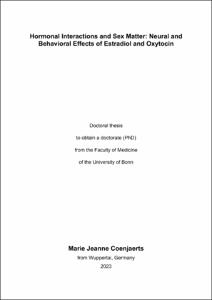Coenjaerts, Marie Jeanne: Hormonal Interactions and Sex Matter: Neural and Behavioral Effects of Estradiol and Oxytocin. - Bonn, 2023. - Dissertation, Rheinische Friedrich-Wilhelms-Universität Bonn.
Online-Ausgabe in bonndoc: https://nbn-resolving.org/urn:nbn:de:hbz:5-72405
Online-Ausgabe in bonndoc: https://nbn-resolving.org/urn:nbn:de:hbz:5-72405
@phdthesis{handle:20.500.11811/11066,
urn: https://nbn-resolving.org/urn:nbn:de:hbz:5-72405,
author = {{Marie Jeanne Coenjaerts}},
title = {Hormonal Interactions and Sex Matter: Neural and Behavioral Effects of Estradiol and Oxytocin},
school = {Rheinische Friedrich-Wilhelms-Universität Bonn},
year = 2023,
month = sep,
note = {The sex hormone estradiol and the neuropeptide oxytocin induce a variety of behavioral and neural effects, but possible underlying interactions have not been tested in a sample involving both sexes. Thus, the current thesis aimed to elucidate sex-specific effects of estradiol, and decipher its interactions with oxytocin.
Study 1 focused on the sex-specific behavioral effects of estradiol on economic decision-making and revealed that it opposingly affects the sensitivity to perceived fairness in women and men. Furthermore, the simple belief in receiving an estradiol treatment altered responses to unfair framed offers in both sexes. Therefore, future studies are warranted to control for stereotypical beliefs associated with a specific treatment, beyond the direct hormonal effects.
Study 2 investigated the impact of estradiol, oxytocin, and their interaction on sex differences in emotional episodic memory. Irrespective of the emotional valence, women exhibited a better overall memory performance than men under placebo, accompanied by increased hippocampus responses to remembered items. The single treatment with estradiol or oxytocin diminished this mnemonic sex difference and reversed the sex-specific hippocampus responses. Intriguingly, the combined treatment produced no significant effect. Hence, the results suggest that the separate treatments modulate sex differences in episodic memory, while their co-administration indicates an antagonistic interaction between both hormones.
To probe task-independent effects, study 3 examined the sex-specific influence of both hormones on hippocampus and amygdala resting-state functional connectivity (rsFC). In women, the single treatments enhanced rsFC between the right hippocampus and the left anterior cingulate gyrus compared to placebo. By contrast, in men, either hormone decreased rsFC between the left amygdala and the right and left lingual gyrus, the right calcarine fissure, and the right superior parietal gyrus. Interestingly, in both sexes, the observed single treatment effects were reversed following the combined treatment, further supporting the notion that both hormones might antagonistically interact.
Collectively, the current thesis detected sex- and region-specific effects of estradiol and oxytocin. Additionally, their potentially antagonistic relation might have contributed to priorly reported opposing hormonal effects in women and men. In conclusion, this thesis highlights the necessity for future studies to consider sex and hormonal interactions, besides simple hormonal effects and stereotypical beliefs, as important moderating factors and to integrate them into their research designs.},
url = {https://hdl.handle.net/20.500.11811/11066}
}
urn: https://nbn-resolving.org/urn:nbn:de:hbz:5-72405,
author = {{Marie Jeanne Coenjaerts}},
title = {Hormonal Interactions and Sex Matter: Neural and Behavioral Effects of Estradiol and Oxytocin},
school = {Rheinische Friedrich-Wilhelms-Universität Bonn},
year = 2023,
month = sep,
note = {The sex hormone estradiol and the neuropeptide oxytocin induce a variety of behavioral and neural effects, but possible underlying interactions have not been tested in a sample involving both sexes. Thus, the current thesis aimed to elucidate sex-specific effects of estradiol, and decipher its interactions with oxytocin.
Study 1 focused on the sex-specific behavioral effects of estradiol on economic decision-making and revealed that it opposingly affects the sensitivity to perceived fairness in women and men. Furthermore, the simple belief in receiving an estradiol treatment altered responses to unfair framed offers in both sexes. Therefore, future studies are warranted to control for stereotypical beliefs associated with a specific treatment, beyond the direct hormonal effects.
Study 2 investigated the impact of estradiol, oxytocin, and their interaction on sex differences in emotional episodic memory. Irrespective of the emotional valence, women exhibited a better overall memory performance than men under placebo, accompanied by increased hippocampus responses to remembered items. The single treatment with estradiol or oxytocin diminished this mnemonic sex difference and reversed the sex-specific hippocampus responses. Intriguingly, the combined treatment produced no significant effect. Hence, the results suggest that the separate treatments modulate sex differences in episodic memory, while their co-administration indicates an antagonistic interaction between both hormones.
To probe task-independent effects, study 3 examined the sex-specific influence of both hormones on hippocampus and amygdala resting-state functional connectivity (rsFC). In women, the single treatments enhanced rsFC between the right hippocampus and the left anterior cingulate gyrus compared to placebo. By contrast, in men, either hormone decreased rsFC between the left amygdala and the right and left lingual gyrus, the right calcarine fissure, and the right superior parietal gyrus. Interestingly, in both sexes, the observed single treatment effects were reversed following the combined treatment, further supporting the notion that both hormones might antagonistically interact.
Collectively, the current thesis detected sex- and region-specific effects of estradiol and oxytocin. Additionally, their potentially antagonistic relation might have contributed to priorly reported opposing hormonal effects in women and men. In conclusion, this thesis highlights the necessity for future studies to consider sex and hormonal interactions, besides simple hormonal effects and stereotypical beliefs, as important moderating factors and to integrate them into their research designs.},
url = {https://hdl.handle.net/20.500.11811/11066}
}






